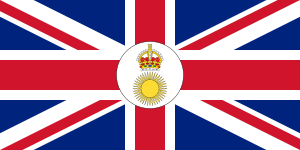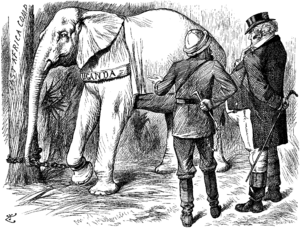Imperial British East Africa Company facts for kids
 |
|
| Public | |
| Industry | Colonial enterprises |
| Fate | Bankruptcy, territory became Uganda Protectorate and East Africa Protectorate |
| Founded | London, United Kingdom 18 April 1888 |
| Founder | William Mackinnon |
| Defunct | 1896 |
|
Area served
|
Uganda Jubaland Kenya |
|
Key people
|
Frederick Lugard |
The Imperial British East Africa Company (IBEAC) was a business group started to help the British Empire trade in parts of Africa. It was founded in London, United Kingdom, on April 18, 1888. Queen Victoria gave it a special permission, called a royal charter, on September 6, 1888.
A Scotsman named William Mackinnon led the company. It grew from his earlier trading work in the area. The British government encouraged this by giving the company an imperial charter.
The IBEAC managed a large area of about 246,800 square miles (639,000 km2) along the eastern coast of Africa. This land stretched from what is now Somalia to modern-day Kenya. The city of Mombasa and its port were very important to the company's work. The IBEAC had the power to collect taxes, set customs duties, and make treaties. It acted like the government in the areas it controlled.
In 1893, the IBEAC gave its control of the territory back to the British Government. The land was then divided. It became the Uganda Protectorate in 1894 and the East Africa Protectorate (which later became Kenya) in 1895.
Contents
The Company's Story
How the Company Started
In the early 1880s, European countries were eager to claim lands in Africa. These lands had not yet been claimed by non-African nations. The Sultanate of Zanzibar and the eastern part of Africa caught the eye of both Germany and Britain.
To avoid conflict, Germany and Britain signed a treaty in 1886. They agreed on which lands each country would try to control. Germany claimed the coast of what is now Tanzania. Britain kept access to the area where Kenya and Uganda are located today.
At that time, Britain was busy with other interests, especially in Southern Africa. Because of this, the British government did not want to take full responsibility for this new region. To make things easier, Britain thought about letting a business company manage and develop the eastern territory. So, in 1888, Sir William Mackinnon and the Imperial British East Africa Company (IBEAC) were given this important job.
What the IBEAC Did
The IBEAC took on the task of adding land from the eastern coast of Kenya all the way to the northwestern shore of Lake Victoria. Besides managing trade and farming, a main goal of the IBEAC was to start building a railway. This railway would connect the east coast region of Mombasa to Lake Victoria.
The company hired James Macdonald and John Wallace Pringle, who were officers in the Royal Engineers. They surveyed the land in 1891–1892. They reported that the area known as Kikuyuland would be good for European settlement. However, the IBEAC did not have enough money to start building the railway.
In 1890, the IBEAC began building the Mackinnon-Sclater road. This was a 600 miles (970 km) ox cart track from Mombasa to Busia on the Uganda border.
The company also ordered a 110-ton steamship, the SS William Mackinnon. This ship was meant to operate on Lake Victoria. It was built in Scotland in 1890 and sent in pieces to Mombasa. But the ship's parts stayed in storage until 1895. This was likely because the IBEAC could not build the railway needed to transport the parts to the lake.
Challenges and End of the Company
Conflicts between different groups eventually stopped the company from investing money and time into its plans. There were four main groups in Uganda: the Kabaka (the king), French Catholics, Protestants, and the IBEAC. They could not solve their disagreements peacefully. Tensions grew, and a civil war started in January 1892. With help from Frederick Lugard, who was building a fort for the company on Kampala Hill, the IBEAC won a difficult victory.
This conflict was the final blow for the company. The IBEAC was already having money problems because of customs issues. The money spent on this fight almost completely bankrupted it. This made it clear that the company could not continue its efforts to control eastern Africa.
The British East Africa Company showed that letting commercial businesses have local government powers was not very effective. So, in 1894, the British government declared Uganda a protectorate. This meant the IBEAC was officially dissolved, and the British government took full control.
The British government finished building the main part of the Mackinnon-Sclater road after the IBEAC ended. The British government also built the Uganda Railway to Kisumu on Lake Victoria between 1896 and 1901. The SS William Mackinnon arrived in Kisumu in pieces in 1898. It was put together and launched in 1900. Like the railway, it was completed and started service in 1901.
More to Explore
- Colonial Heads of Kenya
- German East Africa


